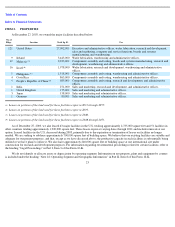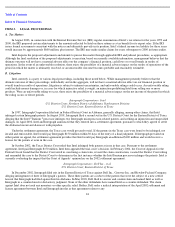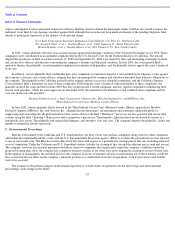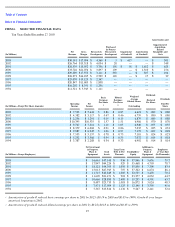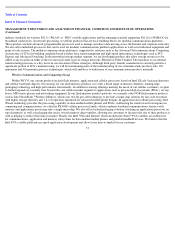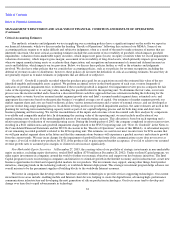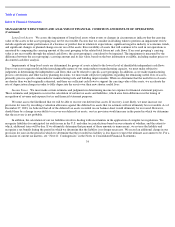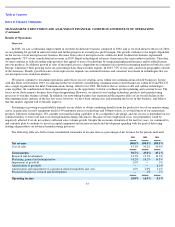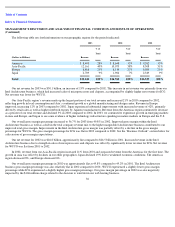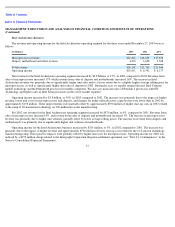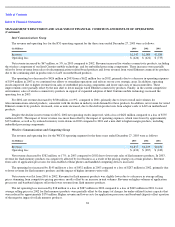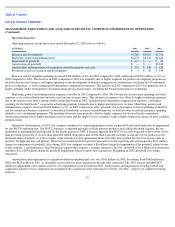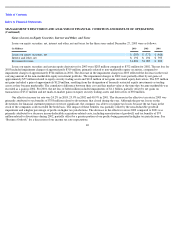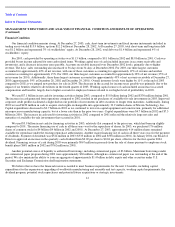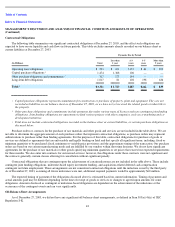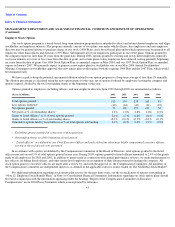Intel 2003 Annual Report Download - page 36
Download and view the complete annual report
Please find page 36 of the 2003 Intel annual report below. You can navigate through the pages in the report by either clicking on the pages listed below, or by using the keyword search tool below to find specific information within the annual report.
Table of Contents
Index to Financial Statements
MANAGEMENT’S DISCUSSION AND ANALYSIS OF FINANCIAL CONDITION AND RESULTS OF OPERATIONS
(Continued)
We typically invest in non-marketable equity securities of private companies and contribute a portion of the funds required for them to
grow. Our investment portfolio ranges from early-stage companies that are often still defining their strategic direction to more mature
companies whose products or technologies may directly support an Intel product or initiative. We invest for strategic reasons, with each
investment also evaluated for potential financial returns. The program seeks to invest in companies and businesses that can succeed and have an
impact on their market segment. However, these types of investments involve a great deal of risk, and there can be no assurance that any
specific company, whether at an early or mature stage, or somewhere in between, will grow or will become successful, and consequently, we
could lose all or part of our investment. When the strategic objectives of an investment have been achieved, or if the investment or business
diverges from our strategic objectives, we may decide to dispose of the investment. However, our investments in non-marketable equity
securities are not liquid, and there can be no assurance that we will be able to dispose of these investments on favorable terms or at all.
As of December 27, 2003, we had invested $124 million in non-voting stock of Elpida Memory, Inc., a Japanese provider of Dynamic
Random Access Memory (DRAM). This investment is intended to help align Elpida’s product roadmap, as appropriate, with our roadmap and
is part of our investment strategy to support the development and supply of DRAM products. No other investment in our non-marketable
portfolio was individually significant.
Our ability to recover our strategic investments in non-marketable equity securities and to earn a return on these investments is primarily
dependent on how successfully these companies are able to execute to their business plans and how well their products are accepted, as well as
their ability to obtain venture capital funding to continue operations, to grow and to take advantage of liquidity events. In the current equity
market environment, their ability to obtain additional funding as well as to take advantage of liquidity events, such as initial public offerings
(IPOs), mergers and private sales, remains constrained.
We review all of our investments quarterly for impairment; however, for non-marketable equity securities, the impairment analysis
requires significant judgment to identify events or circumstances that would likely have a significant adverse effect on the fair value of the
investment. The indicators that we use to identify those events or circumstances include (a) the investee’s revenue and earnings trends relative
to predefined milestones and overall business prospects, (b) the technological feasibility of the investee’s products and technologies, (c) the
general market conditions in the investee’s industry, and (d) the investee’s liquidity, debt ratios and the rate at which the investee is using its
cash.
Investments identified as having an indicator of impairment are subject to further analysis to determine if the investment is other than
temporarily impaired, in which case we write the investment down to its impaired value. When an investee is not considered viable from a
financial or technological point of view, we write down the entire investment since we consider the estimated fair market value to be nominal.
If an investee obtains additional funding at a valuation lower than our carrying amount or requires a new round of equity funding to stay in
operation and the new funding does not appear imminent, we presume that the investment is other than temporarily impaired, unless specific
facts and circumstances indicate otherwise.
We have experienced substantial impairments in our portfolio of non-
marketable equity securities as equity markets declined significantly
over the past few years. If the level of IPO market activity does not increase and the availability of venture capital funding for technology
investments does not improve, our non-marketable investments may be adversely affected. As companies within our portfolio attempt to raise
additional funds, the funds may not be available to them or they may receive lower valuations, with less favorable investment terms than in
previous financings, and the investments would likely become impaired. However, we are not able to determine at the present time which
specific investments are likely to be impaired in the future, or the extent or timing of individual impairments. Impairments of investments in
our portfolio, primarily impairments of non-marketable equity securities, were $319 million in 2003 ($524 million in 2002 and $1.1 billion in
2001).
Inventory. The valuation of inventory requires us to estimate obsolete or excess inventory as well as inventory that is not of saleable
quality. The determination of obsolete or excess inventory requires us to estimate the future demand for our products within specific time
horizons, generally six months or less. The estimates of future demand that we use in the valuation of inventory are the basis for our published
revenue forecast, which is also consistent with our short-term manufacturing plan. If our demand forecast for specific products is greater than
actual demand and we fail to reduce manufacturing output accordingly, we could be required to record additional inventory reserves, which
would have a negative impact on our gross margin.
33


